9 Gas BBQ Grill Safety Basics
(Plus Bonus – 16 Cooking Tips for Great BBQ Food)
BBQ time is here!
It’s time to review our BBQ safety basics for a safe BBQ season…
What are the Gas BBQ Grill Safety Basics?
The gas BBQ grill safety basic in summary…
- BBQ Emergency Procedures
- BBQ Placement
- Safe gas bottle storage
- Preventing BBQ gas fires
- The correct way to turn of the gas
- Connecting & disconnecting gas bottles
- BBQ leak test
Keep reading for all the details of each…
1. BBQ Gas Leak Test
It is important to regularly leak test your BBQ gas bottle, regulator and hose. Leaks from these items are frequently the cause of BBQ gas fires.
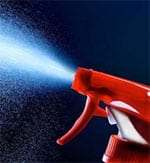 How to Test:
How to Test:
Put some soapy water in a spray bottle.
Turn on the gas bottle without turning on the BBQ.
Next, spray the entire valve, regulator and hose assembly with the soapy water.
Bubbles will form if there is a gas leak and you may also smell the gas.
When done, rinse with clean water to remove the soap solution.
For more details, please see: BBQ Gas Leak Test
2. How To Safely Attach or Change Your BBQ Gas Bottle
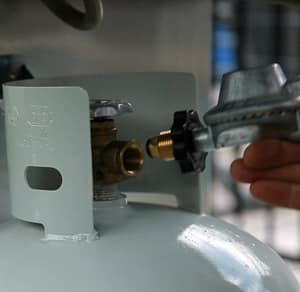 Connecting & Disconnecting: Newer LCC27 regulators have a normal right-handed thread.
Connecting & Disconnecting: Newer LCC27 regulators have a normal right-handed thread.
Older POL regulators have a reverse or left-handed thread.
So, to detach, you turn a LCC27 connection anti-clockwise and then clockwise to re-attach.
To detach, you turn a POL connection clockwise and then anti-clockwise to re-attach.
For full step-by-step instructions, please see: How to Attach or Change Your BBQ Gas Bottle
3. Turn Your BBQ Off at the Gas Bottle First
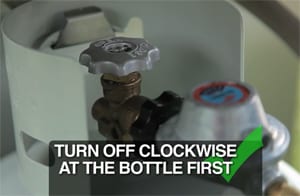 The best practice is to get onto the habit of turning your BBQ off at the gas bottle first.
The best practice is to get onto the habit of turning your BBQ off at the gas bottle first.
This does three important things.
First, it ensures that you don’t completely forget to close the gas bottle valve.
It also uses up all of the gas remaining in the gas lines so you are safely storing your BBQ with no remnant gas remaining in the unit.
More importantly, it eliminates the possibility of leaks from all of the burners and the regulator connection while in storage.
Please see: Turn Your BBQ Off at the Gas Bottle First
4. How to Prevent BBQ Gas Fires
The real culprit in gas BBQ fires is typically the hose or regulator.
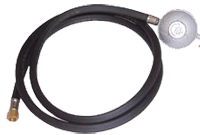 Hoses and regulators deteriorate with age and can start leaking.
Hoses and regulators deteriorate with age and can start leaking.
It’s the gas coming from these leaks that ignites and causes the vast majority of BBQ fires.
You should visually inspect the hose for cracking, splitting or other damage.
You should inspect the regulator for damage, paying special attention to the part that screws into the gas cylinder.
It should be clean, undamaged and if it has rubber O-rings, they also need to be undamaged.
BBQ Safety Video
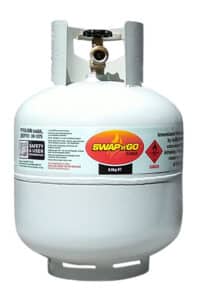 5. Safe Storage of Your Gas Bottle
5. Safe Storage of Your Gas Bottle
It is best to store gas bottles outdoors in a well ventilated space.
Gas bottles should never be stored indoors.
Gas bottles should always be stored upright and away from any ignition source.
If you store your BBQ or patio heater indoors, when not in use, you should always detach the gas bottle first and store it separately outdoors
6. Where to Place Your BBQ for Use
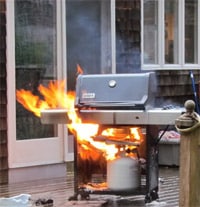 BBQs should never be used near flammable objects, as BBQ gas fires can happen (see image).
BBQs should never be used near flammable objects, as BBQ gas fires can happen (see image).
Keep at least 3m (10ft) between the BBQ and your home or any flammable material.
Adequate ventilation is essential when using a BBQ to allow the gas to burn and burnt gases to dissipate.
BBQs should NEVER be used indoors because of the risk of toxic fumes, smoke or even fire
Children should be kept safely away from gas BBQs and gas bottles.
7. BBQ Emergency Procedures
If any leakage from the valve of a BBQ gas bottle is detected or suspected, move the gas bottle to a safe location at least 20 metres from any possible source of ignition.
Check valve is turned off. Keep away from flames and sparks and hose with water.
If it is not possible to stop the leak, keep the leak uppermost so that only gas, and not liquid, escapes.
Keep hands and face away from any escaping gas or liquid.
In an emergency dial 000 for Fire Brigade or Police
8. Charcoal vs Propane Health Issues
A big problem with charcoal is that it emits almost 3x the amount of CO2 that is produced when you use LPG (Propane).
This greenhouse gas depletes the ozone layer which, in turn, increases the risk of skin cancers.
Charcoal is also derived from biomass and creates much more smoke and particulates.
Both have adverse health effects.
A scientific study also revealed that meats grilled with charcoal contained more carcinogens than meat heated with LPG.
These carcinogens are called polycyclic aromatic hydrocarbons – PAHs.
Charcoal also burns hotter, charring the meat and creating HCA (heterocyclic amines), which is yet another carcinogen.
So, LPG grilling is arguably healthier than using charcoal.
9. What is the Best Gas BBQ
What is the best gas BBQ? The answer is not what you expect…
The best gas BBQ is the safest gas BBQ.
The same is true for best small gas BBQ and best outdoor gas grills.
This means a BBQ that has a safety certification label and is well maintained.
Everything else falls under the category of convenience features.
Nice to have but not essential.
16 BBQ Cooking Tips for Great Grilling
1. Ice it, Cook it or Eat it
Keep it clean and keep it cold until you cook it or eat it.
Practice good food safety and preparation.
2. Oil Me Up!
You should always season the grill.
Pre-heat the clean grill and coat with cooking oil, using a brush or spray.
Close the grill and allow it to sit for about 20 minutes then wipe the grill clean with a fresh damp cloth.
The concept is the same as the seasoning of a cast iron fry pan.
3. To Be or Not to Be Open… That is the Question
So, how do you position the BBQ lid?
Just as some things are cooked on the kitchen cooktop and some in the oven, the type of food you are cooking will determine if you leave the BBQ lid up or down.
Generally speaking, do what you would do if you were cooking indoors.
4. Now We’re Cooking – Outside In
Steaks, burgers, and veggies, that need to be seared or cooked from the outside inward, should be placed directly over the burners.
A little olive oil brushed on the steak will prevent it from sticking.
Do NOT use salt on the meat before cooking, as it draws out the moisture and makes the meat dry.
If you do salt it as you start cooking, use coarse salt to get a nice salty crust.
A bit of coarse black pepper can be nice, too.
5. Stunning Striped Steaks
Always pre-heat the grill and take the meat out of the refrigerator about 15 minutes before cooking.
Sear the meat for 90 seconds on high heat and then rotate it 1/8 of a turn (45 degrees) and sear again.
This will give it an attractive crosshatch pattern, assuming you are not cooking on a flat plate grill, and help seal in the natural juices.
Remember to reduce heat to normal cooking temperature after searing.
6. I Need My Space
You should only turn the meat once. Be patient!
The meat needs room, too. Don’t overcrowd the grill or it can heat unevenly.
There should be at least 2cm between the pieces of meat.
Also, make sure you have enough gas so that the cooking session is uninterrupted.
7. No Poking, Prodding or Mashing
To retain the natural juices, don’t poke holes in the meat! This includes piercing the sausage skins.
Use long handled tongs or spatulas instead of BBQ forks.
Also, don’t mash down on meat and burgers, as it forces out the natural juices and leaves you with dried out meat.
8. Leave Me Alone… I’m Resting
Let your grilled meat “rest” for five minutes after cooking, covered loosely with foil, to ensure more tender and juicy results.
Letting the meat rest also applies to roasts and other cooked meats, as well.
9. Slow Cooking – Inside Out
Whole chickens, roasts, and most fish fillets require indirect heat.
Try preheating the grill with all burners then, when the grill is hot, turn off one side of grill, put the slow cooking food over the unlit burners and close the lid.
In effect, it becomes an oven. This will help cook the meat evenly, browning it while keeping it juicy and tender.
Use a meat thermometer, where appropriate, to determine when it is done.
10. Pouch Protector Preparation
You can use aluminium foil to create little cooking pouches for delicate foods, like fish fillets.
Cook away from the lit burners or place the pouch on the warming rack, if you have one.
11. Warm & Wonderful
You can toast bread, cook delicate foods or just keep cooked food warm by using your warming rack.
12. I’m Smokin’!!!
Wood chip smoke can enhance the flavour of your food.
You put the wood chips in a steel smoker box or in a small aluminium foil tray within the BBQ.
Hickory is a good all-round choice, if you are just starting.
Smoker boxes and wood chips can be found at BBQ specialty stores. Follow the wood chip supplier’s instructions.
13. Leftover Pizza?
Did you know that a gas grill is the perfect way to reheat pizza?
Just set the BBQ on low, preheat, put the pizza directly on the grill and close the lid.
Heat until cheese starts to melt.
14. Flare Up? Lid Down!
Use lean cuts of meat and/or trim away the fat to reduce the chance of flare ups.
Make sure the grease tray is empty before you start, too. Very high temperatures should also be avoided.
However, if it does happen, flip down the grill lid and turn OFF all burners and the gas bottle, if safe to do so.
When the flare up is over, you can resume cooking.
NEVER spray water on BBQ flare ups or on any grease fire.
15. Marvelous Marinated Meat
For more intense or varied flavours, consider using meat marinades.
You marinate the meat before you BBQ, as instructed by the marinade maker or recipe.
You can use large freezer bags for marinating.
Just put in the meat and marinade, seal and shake. Refrigerate, shaking it occasionally, until you’re ready to BBQ.
Make sure you drain off any excess marinade before cooking and do NOT pour it over the meat while cooking.
16. A Little Something on the Side
If your BBQ is equipped with a side burner, you can use it just like a kitchen cooktop.
This adds to the selection of dishes you can choose to cook outdoors.
- Elgas to the Rescue with Helicopter LPG Delivery - November 14, 2024
- Gas Patio Heater Guide: Outdoor Gas Heaters – Outdoor Mushroom Heater - September 22, 2024
- LPG Meaning – LPG Means: What Does LPG Stand For - August 31, 2024
Steve Reynolds
Technical Consultant
Steve Reynolds is a leading expert in the LPG industry with over 22 years of experience. As part of the national management team at ELGAS, Steve ensures the safe and efficient storage, handling, and transportation of LPG. He serves as the lead investigator for incidents and collaborates with authorities on industry developments.
Steve is a technical advisor to Standards Australia and Gas Energy Australia (GEA), and an active member of the World LPG Association (WLPGA), contributing to global standards and technical reviews. He holds a BSc. (Hons) in Industrial Chemistry from UNSW and has held senior safety and technical roles at ELGAS, making him a trusted authority in LPG safety and standards.

